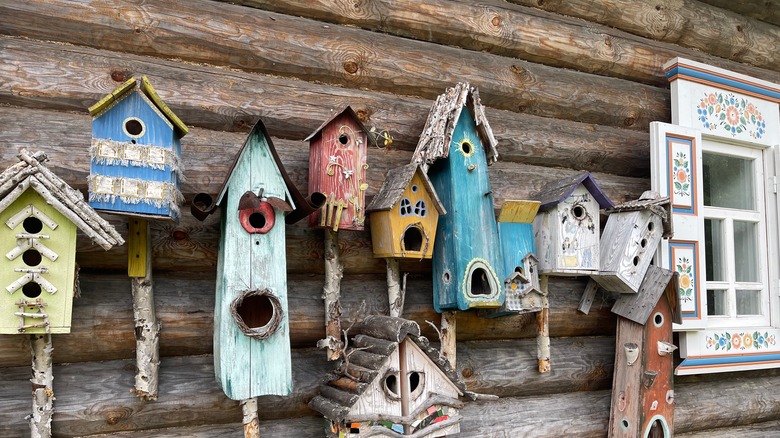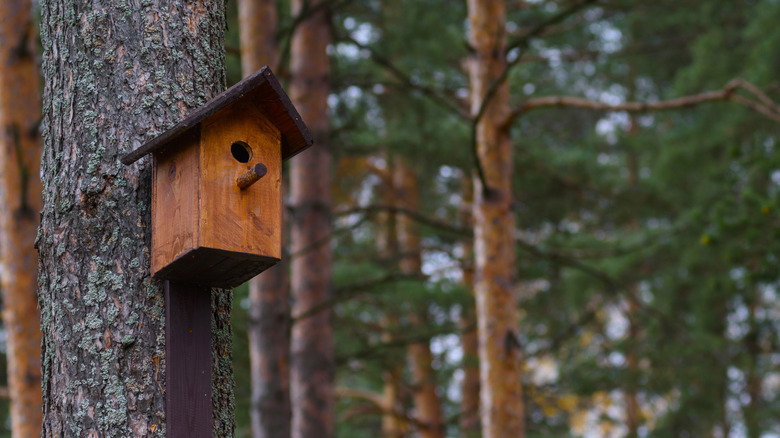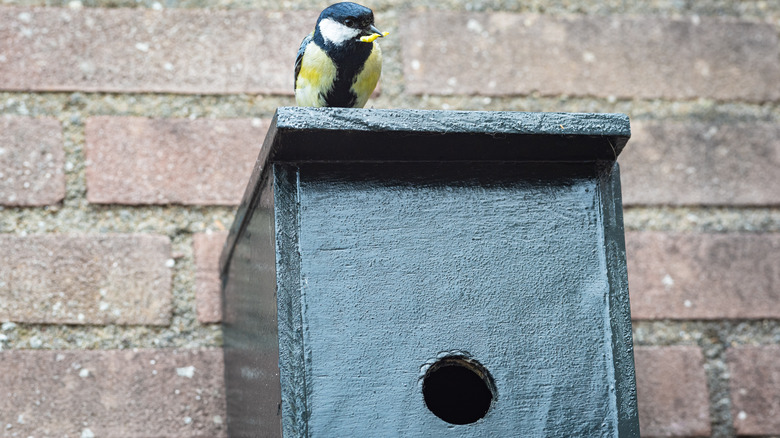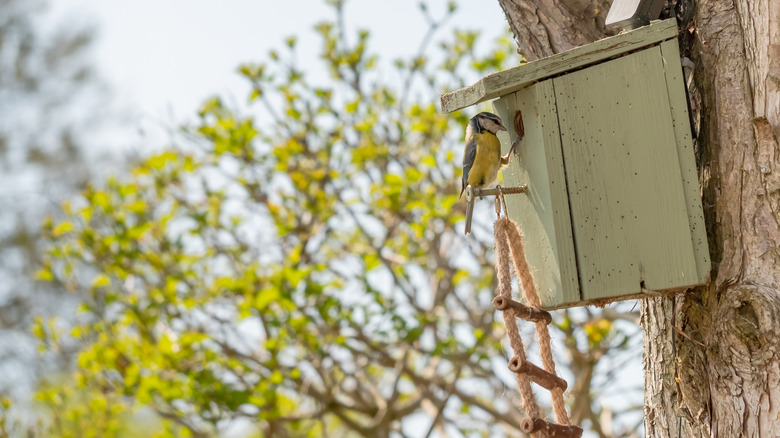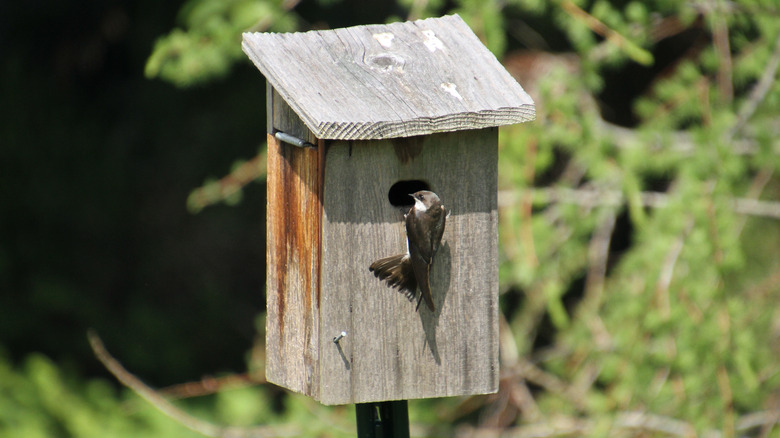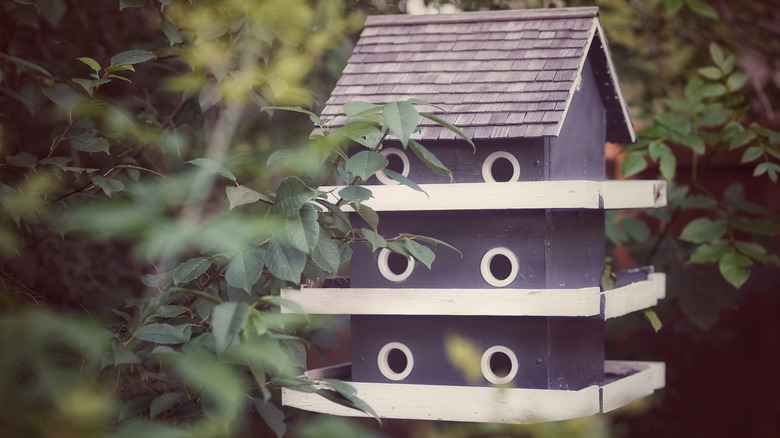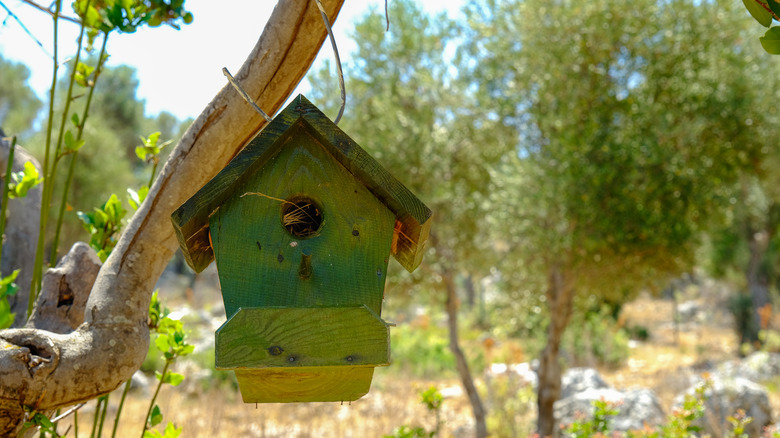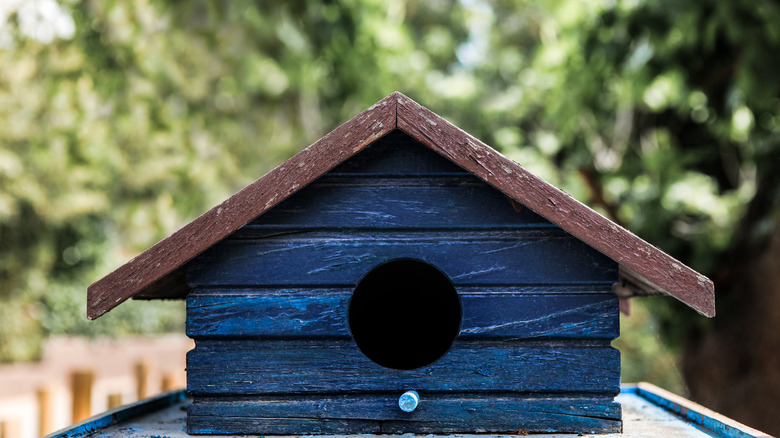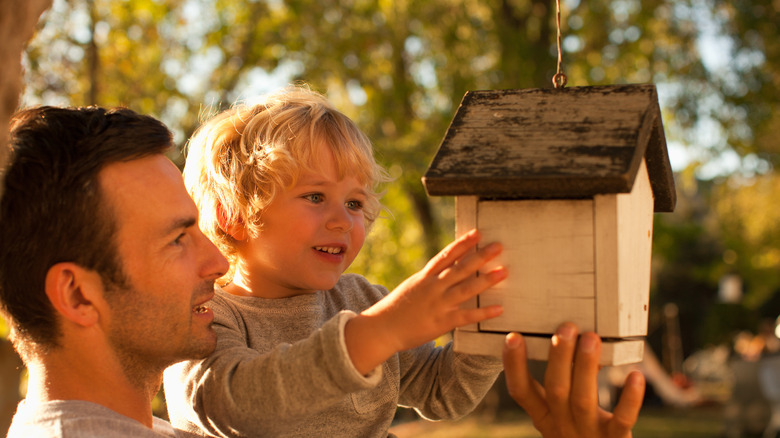Use These 8 Stunning Colors On Your Birdhouse To Attract More Flying Friends
Have you started waiting for your feathered friends to come visit your yard every day, greeting them like old acquaintances whenever you recognize a familiar plumage? If you love attracting them to your garden but notice that birds are avoiding your birdhouse, it might be the color of the tiny home that's putting them off. Bird's eyes are extremely perceptive to colors, and the extra receptors in their genetics grant them a much more intense visual experience than humans could ever imagine. Because of this, they are sensitive to colors, and certain hues either alert them to threats or entice them to take up residence in an area they perceive as safe.
To see more birds in your yard, why not just upgrade the paint job on your birdhouse to one of the following eight colors? This will send an open invite to the feathered occupants of your area, encouraging them to use your yard as a place to rest, eat, and visit whenever they'd like. The following colors can help provide the ideal respite for your favorite species and maybe even bring some new friends along as well.
If you're wondering if it's even safe to paint a bird feeder, the answer is yes. However, it's important to use exterior paint that can withstand the elements better than other options and avoid anything metallic or florescent that could contain harmful ingredients to birds. Further, only paint the outside of the structure and not the interior.
1. Brown
Nesting birds are ideal creatures to entice for anyone who loves the idea of owning a bird but doesn't want the responsibility. They hang around your yard so you can watch them and enjoy their habits but don't require more than somewhere safe to raise their young. They even act as pest control, catching insects and rodents that could otherwise wreak havoc on your outdoor area. While choosing the right type of birdhouse for your yard is important, keep in mind that these birds prefer colors that provide camouflage, which is why brown shades are a good choice. Safety can be found among tree branches and foliage, all of which come in varying shades of this neutral.
Pick an earthy tone that still brings an appealing aesthetic to your garden. PERMANIZER's Bird House Brown exterior paint offers a clean, standard hue that will match any outdoor aesthetic. If you want to try something a little lighter, Glidden's Tattered Teddy is still within the more natural shades found outdoors but can bring a brighter focal point to your yard.
2. Gray blue
However, your birdhouse doesn't have to be covered in earthy tones to attract flying friends. One of the more popular colors for these tiny avian homes is gray blue. Sherwin-Williams' Slate Tile is a great cross between gray and blue, muted enough that it won't deter birds but colorful enough to bring some excitement to your yard. Bluebirds, starlings, and owls all seem drawn in by blues, so when used on a birdhouse, you can encourage these to pop by for a visit.
It's important to remember that despite their preference for blue shades, these species still understand their need for safety, so bright hues are discouraged. Loud colors can give away their locations to their predators, so they avoid these. Some species like blue jays and bluebirds are pulled in by shades similar to their plumage, and owls prefer hues that reside on a cooler color scale, possibly because of their nocturnal tendencies.
3. Muted green
It's no surprise that a green birdhouse would attract feathered visitors. Like the foliage they enjoy, green signals safety to nesting birds and allows any that want to pop by for a quick rest the same sense of security. Greens like BEHR's Muted Sage are best and also blend in well with your garden. Forgo jewel tones or bright green options, as these can catch the eye of some birds but also predators, so fewer feathred friends will hang around.
If you wanted to add a little pizazz to your muted green, you could try painting the trim or roof of the birdhouse a lighter or darker shade to add a little depth. Additionally, if you have creative family members, they could even add painted foliage along the exterior for a fun activity and a way to upgrade the color. These should still be in understated or muted tones, but that doesn't mean your birdhouse can't look fun and a little artistic.
4. Gray
Gray rates highly on suggested colors for birdhouses, too. This option can be added in varying shades, like BEHR's Ultra Dark Ash Satin or Glidden's Flagstone, and is an easy neutral to use in any garden or backyard design. The simple color, especially in light tones, can be a better option than black, which will absorb lots of sunlight and could make the inside of the birdhouse too hot. While it might be tempting to lean into a more silvery tone, reflective paints aren't recommended for the same reasons bright colors should be avoided.
If you're stuck for choice on what shade of gray to use, look for inspiration around your yard. Match your birdhouse to paving stones, rocks, or even furniture so that the colors flow and complement one another. If your garden features a lot of darker colors in the landscaping, opt for a medium gray. If you have gravel or stones that are white or lighter in color, a brighter gray will match well but still provide the safe color that birds prefer.
5. Soft or dark purple
While it's true that birds are attracted to bright colors for feeders and of course natural flora and fauna, they are less inclined to hang around a birdhouse that features bright reds or oranges. This could be because birdhouses represent a place for long-term respite, while feeders are just a quick visit to wet the whistle and grab a bite. That being said, opting for purple hues can still bring a pop of color without deterring birds who prefer a long-stay option.
Like with blue, softer purples are less intense for nesting birds, and nocturnal birds may also enjoy a house painted in varying shades of cool purple. Farrow and Ball's Imperial Purple is a great choice that will look lovely on any garden backdrop. If you already have blooms in this palette, they will work to both disguise and enhance the birdhouse exterior, creating a colorful theme that both draws birds in and elevates your yard.
6. Muted olive
Olive green offers a nice variation from the lighter sage hue, providing a darker or more earthy option for anyone who prefers to lean into a more dramatic color. PERMANIZER's Olive Green or Glidden Premium's Oakmoss are simple answers for those looking to paint their birdhouse in this shade. The flat finish of these paint shades ensures birds won't see a shiny glare and avoid the abode, and the inkier tones will encourage them to feel safe since they look camouflaged when mixed with the surrounding foliage.
To add more depth or personalize the house, you can also add brown trim to build on the nature theme the olive color produces. Or, if that feels too camouflaged, combine this with lighter sage green for a more dimensional finish. You can also plant berry-producing plants like holly and red mulberry nearby. This will not only entice more feathered friends to visit but will also add to the concealment provided by the green hues, protecting your visitors from predators.
7. Dark blue
If you like the idea of using blue but want something a little more inky, Dunn-Edwards' Summer Night is still muted enough so it won't put off birds who are drawn in by this color palette but darker than the aforementioned grayish blue. If your yard features blue florals, natural wood, and even blue accents, this is a great way to pull those colors through the entire outdoor area. The tone of this shade provides a more dramatic finish and could help bring both diurnal and nocturnal birds to your garden.
You can choose from a matte or flat finish, both of which will look neat and tidy on the birdhouse without creating any shine that might draw the bird's predators' attention. However, since some darker shades can absorb more heat, place the house somewhere protected by shade in the warmer months to keep the interior from becoming too hot. This will also help with blending the dwelling into natural foliage, thereby attracting more birds.
8. Cream
Maybe the idea of a white birdhouse is intriguing but you don't want to commit to such a bright color that might stick out or deter certain species. Many birds don't like bright white because it can be seen as a warning signal of danger. Instead, beige or tan shades like BEHR Premium Plus' Spanish Sand can offer an alternative that is still within the white color palette but brings a little more of a calming hue to your birdhouse's exterior and keeps it from overheating in the summer.
Soft and mellow, this is a good choice for anyone who wants to bring Purple Martins in, since these don't mind the white that may repel other birds. Cream is great for attracting this blue songbird, but keep in mind that these birds usually prefer nesting in an abode that is kept clear of obstacles, so keep branches and foliage away from the front of the home. The beige will both level out the brightness of the white palette and keep your regular visitors cool in warm weather, so it's a win-win for anyone who opts for this color.
